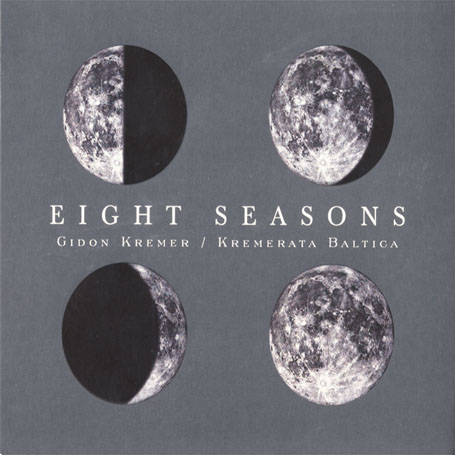Eight Seasons
Two worlds brought together by a mind that loves both - a strange but alluring combination, brilliantly realised and superbly recorded
View record and artist detailsRecord and Artist Details
Composer or Director: Antonio Vivaldi, Astor Piazzolla
Label: Nonesuch
Magazine Review Date: 5/2000
Media Format: CD or Download
Media Runtime: 64
Mastering:
DDD
Catalogue Number: 7559 79568-2

Tracks:
| Composition | Artist Credit |
|---|---|
| (12) Concerti for Violin and Strings, '(Il) cimento dell'armonia e dell'inventione', Movement: No. 1 in E, 'Spring', RV269 |
Antonio Vivaldi, Composer
Antonio Vivaldi, Composer Gidon Kremer, Violin Kremerata Baltica |
| (12) Concerti for Violin and Strings, '(Il) cimento dell'armonia e dell'inventione', Movement: No. 2 in G minor, 'Summer', RV315 |
Antonio Vivaldi, Composer
Antonio Vivaldi, Composer Gidon Kremer, Violin Kremerata Baltica |
| (12) Concerti for Violin and Strings, '(Il) cimento dell'armonia e dell'inventione', Movement: No. 3 in F, 'Autumn', RV293 |
Antonio Vivaldi, Composer
Antonio Vivaldi, Composer Gidon Kremer, Violin Kremerata Baltica |
| (12) Concerti for Violin and Strings, '(Il) cimento dell'armonia e dell'inventione', Movement: No. 4 in F minor, 'Winter', RV297 |
Antonio Vivaldi, Composer
Antonio Vivaldi, Composer Gidon Kremer, Violin Kremerata Baltica |
| (Las) Cuatro Estaciones porteñas, 'The Four Seasons' |
Astor Piazzolla, Composer
Astor Piazzolla, Composer Gidon Kremer, Violin Kremerata Baltica |
Author: Rob Cowan
Baroque visits tango, one season becomes another or, as Gidon Kremer himself puts it, 'the globe, being round, implies two hemispheres'. We first encountered the idea at last year's Proms and now we have it on disc, coolly attenuated Vivaldi meets hot-headed Piazzolla, both of them bristling with life. Search a little beneath the surface, and there are certain parallels. Both composers alternate fast and slow episodes; both call on similar instrumentation, and in two cases Piazzolla (as arranged by Leonid Desyatnikov) actually quotes Vivaldi, bringing the Red Priest's Winter to his own Summer, then warming a Piazzollan Winter with a touch of Vivaldi's Summer.
This is no crossover, but a creative juxtaposition of disparate styles. New neighbours mean a new lease of life for both, and the switch never jars - mainly because Kremer's dancing, sound-conscious and consistently spontaneous playing style is a common attribute. I've never heard his violin, indeed any violin, sound better on disc - creamy and keen-edged, with every subtle nuance cleanly reproduced.
After Vivaldi's 'Spring', Piazzolla kicks in with 'Summer in Buenos Aires', a darkly dancing tango that soon softens to a characteristic brand of melancholy. Vivaldi's 'Summer' enters on a live wire, sul ponticello, with keen accents and much chirruping among the fiddles. Piazzolla's 'Autumn in Buenos Aires' alternates writing for solo violin and cello whereas Vivaldi's 'Autumn' is bright, fast, freely improvisational and with a marked crescendo over the start of the third movement. 'Winter in Buenos Aires' sets off to a sombre cello solo then, after a violin cadenza, starts to speed up. Vivaldi's Largo ('Winter') has one of the fastest plucked showers I've ever heard - just 1'13'' and with a highly mobile bowed bass line. The sequence ends, as it began, with Spring ... this time 'in Buenos Aires', a devil-may-care mix of yearning, sadness and heady exultation.
I loved it all but if you just fancy hearing Kremer's plucky, versicoloured Four Seasons on its own, you can always programme your CD player to dispense with the rest. Personally, though, I'd play the programme as planned.'
This is no crossover, but a creative juxtaposition of disparate styles. New neighbours mean a new lease of life for both, and the switch never jars - mainly because Kremer's dancing, sound-conscious and consistently spontaneous playing style is a common attribute. I've never heard his violin, indeed any violin, sound better on disc - creamy and keen-edged, with every subtle nuance cleanly reproduced.
After Vivaldi's 'Spring', Piazzolla kicks in with 'Summer in Buenos Aires', a darkly dancing tango that soon softens to a characteristic brand of melancholy. Vivaldi's 'Summer' enters on a live wire, sul ponticello, with keen accents and much chirruping among the fiddles. Piazzolla's 'Autumn in Buenos Aires' alternates writing for solo violin and cello whereas Vivaldi's 'Autumn' is bright, fast, freely improvisational and with a marked crescendo over the start of the third movement. 'Winter in Buenos Aires' sets off to a sombre cello solo then, after a violin cadenza, starts to speed up. Vivaldi's Largo ('Winter') has one of the fastest plucked showers I've ever heard - just 1'13'' and with a highly mobile bowed bass line. The sequence ends, as it began, with Spring ... this time 'in Buenos Aires', a devil-may-care mix of yearning, sadness and heady exultation.
I loved it all but if you just fancy hearing Kremer's plucky, versicoloured Four Seasons on its own, you can always programme your CD player to dispense with the rest. Personally, though, I'd play the programme as planned.'
Discover the world's largest classical music catalogue with Presto Music.

Gramophone Digital Club
- Digital Edition
- Digital Archive
- Reviews Database
- Full website access
From £8.75 / month
Subscribe
Gramophone Full Club
- Print Edition
- Digital Edition
- Digital Archive
- Reviews Database
- Full website access
From £11.00 / month
Subscribe
If you are a library, university or other organisation that would be interested in an institutional subscription to Gramophone please click here for further information.




